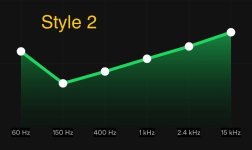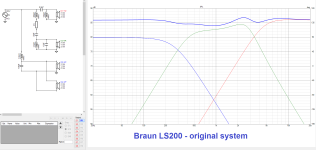I'm looking to modify my beloved Braun LS200 speakers. In fact, they're nice speakers but I'm curious to know. The LS200 are 3-way system with 4 drivers including 2 twin woofers. I've played with them by unplugging other drivers and listen to a single driver. I found that the woofers not only play bass but also midrange. I, then, tried using graphic equalizer and discovered that eliminating midrange from the woofers satisfied me. I tried tweaking passive crossovers many times to suit the setting on EQ, but, none of them archived the target.
However, I have the last method. I found the schematic of B&W Matrix 3 series 2 which are 2.5-way system. It sparked an idea. Attached is the low-pass filter circuit of the B&W.

Regarding L2 (8 mH) on the B&W's schematic, I think to add a large inductor to one of the LS200's woofers, red circle in the picture.

The objective is to limit the midrange from one woofer. On the other hand, my LS200 would be converted to 3.5-way system. Anyway, I have 5.6, 6.6 and 8.2 mH inductors in my hand. I'm thinking to try them all. But, I'm not sure whether it will create any problems. Please advice if there're problems occur; such as too low impedance, distortion created, or low-pass filter modification needed, etc. If there're any, then, I will stop this project. But if it's fine, I will go on.
However, I have the last method. I found the schematic of B&W Matrix 3 series 2 which are 2.5-way system. It sparked an idea. Attached is the low-pass filter circuit of the B&W.
Regarding L2 (8 mH) on the B&W's schematic, I think to add a large inductor to one of the LS200's woofers, red circle in the picture.
The objective is to limit the midrange from one woofer. On the other hand, my LS200 would be converted to 3.5-way system. Anyway, I have 5.6, 6.6 and 8.2 mH inductors in my hand. I'm thinking to try them all. But, I'm not sure whether it will create any problems. Please advice if there're problems occur; such as too low impedance, distortion created, or low-pass filter modification needed, etc. If there're any, then, I will stop this project. But if it's fine, I will go on.
Last edited by a moderator:
I don't think there could be any problems for the amp or the speakers. Go on!But if it's fine, I will go on.
Hi,
With such a large inductance sensivity of one driver will drop also in bass, so I do not think it will give similar results that you achieved by using eq.
Also the impedance seen by prevous stage will change, so x-o frequency of another driver will be affected.
Worth experimenting it, but using modeling program is highly suggested.
Regards
With such a large inductance sensivity of one driver will drop also in bass, so I do not think it will give similar results that you achieved by using eq.
Also the impedance seen by prevous stage will change, so x-o frequency of another driver will be affected.
Worth experimenting it, but using modeling program is highly suggested.
Regards
If the drivers has the back open (usually woofers do) there may be an interference between the woofers at the cutoff frequency of the new inductor and the LS resistance, as the phases of the cones now will not be synchronized as they was when paralleled directly.
To date, I’ve been playing with EQ. I discovered that there are two styles of EQ that satisfy me. The only difference between them is at 150Hz position. For style 1, the 150Hz will be aligned linearly to the 60Hz and the 400Hz will be the lowest position. While, in style 2, the 150Hz will be the lowest point and linearly aligned from 400Hz. As can be seen, the change only involved with the response of the woofers.
This is a bit puzzled to interpret whether the addition of a large inductor to one of the woofers, or 3.5-way conversion, will produce these results. Or, from another point of view, it may be interpret that these results are obtained by the change of low-pass’s “slope”. For instance, 12dB/octave vs. 24dB/octave slopes.
Which one is correct, the former or the latter, please?
This is a bit puzzled to interpret whether the addition of a large inductor to one of the woofers, or 3.5-way conversion, will produce these results. Or, from another point of view, it may be interpret that these results are obtained by the change of low-pass’s “slope”. For instance, 12dB/octave vs. 24dB/octave slopes.
Which one is correct, the former or the latter, please?
Attachments
Although it's difficult to tell without seeing phase, it seems the two woofers and mid are largely working together with both crossovers. I might guess from that they will be comparable, at least according to differences in the total response plot.
@presscot Whether or not the modification is "acceptable" or not is quite open to conjecture. What do the original speakers sound like? If they appear to have an excess of output in the 100–200Hz frequency band, then your modification could prove subjectively beneficial. Your change is relatively minor, so it may not be obvious on a lot of program material.I've tried simulations. Here are the results.
View attachment 1301034
View attachment 1301033
Is this modification acceptable? What do you think about it, please?
Even before doing the modification, its possible to test it out using a first-order approximation. Just apply equalisation to mimic the target response change that the modification will introduce. Test it with lots of recordings. If you consider that it produces a worthwhile subjective improvement, then it could then be meaningful to make the requisite changes to the crossover based on the results of the listening tests.
- Home
- Loudspeakers
- Multi-Way
- Is this solution acceptable?



